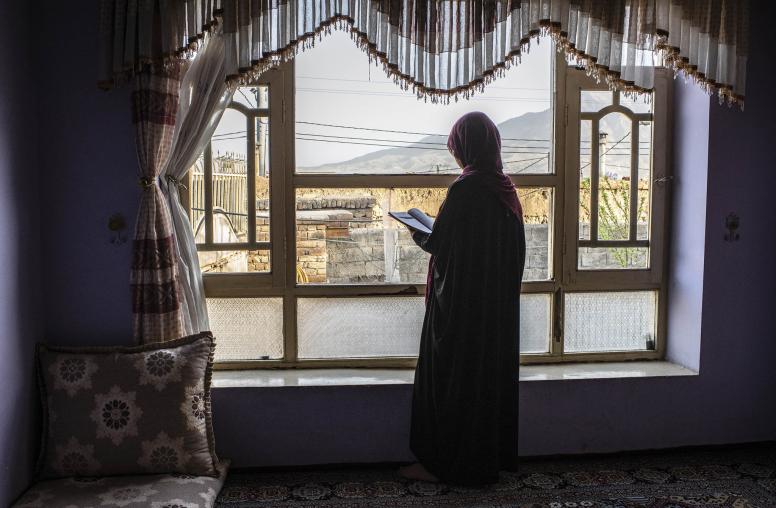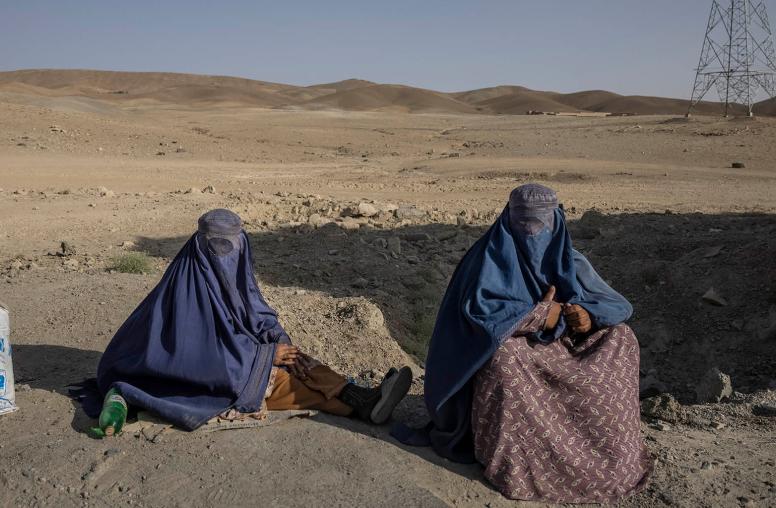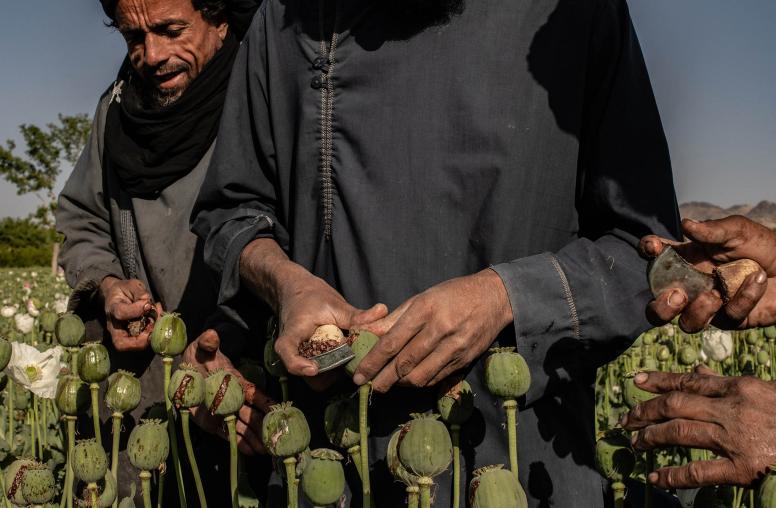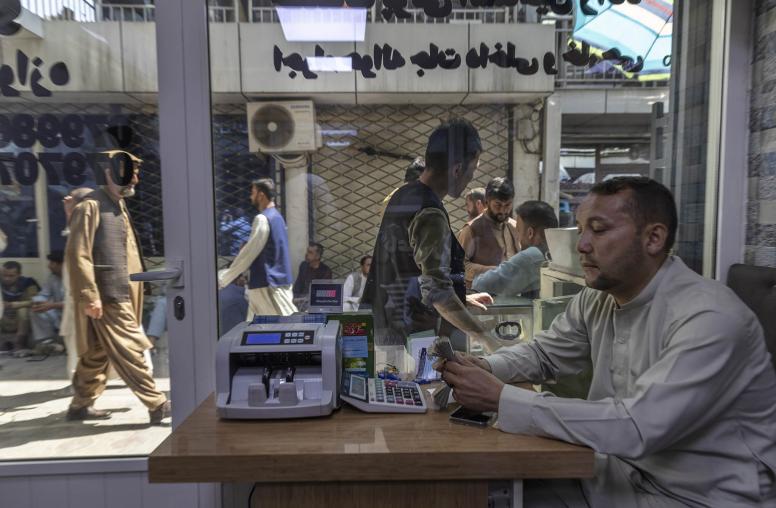Taliban Escalate New Abuses Against Afghan Women, Girls
Officials, armed fighters widen ‘enforcement,’ beatings, puberty exams for schoolgirls.
Afghanistan’s Taliban are escalating restrictions against women, sending armed men into girls’ classrooms and forcing staff to inspect girls’ bodies for signs of puberty to disqualify them from further schooling. Afghan women report Taliban enforcers beating women whom they find wearing Western-style pants beneath their regime-mandated outer robes. The Taliban are intensifying these assaults in response to women’s rights campaigns in Afghanistan and Iran, and amid their own struggle to consolidate power. The Taliban’s intensifying violations against women risk mass atrocities and may presage greater violent extremism and threats to international security. Policymakers must respond.

Taliban Repression — and Its Danger
The new abuses of women reflect Afghanistan’s manifold, rising crises. Fourteen months after the Taliban recovered power in Kabul, they rule by force and are unlikely to make any significant effort to broaden the base of their regime, USIP analyst William Byrd argues. Their repressiveness is heightened by the country’s economic collapse.
The Taliban’s top leaders — largely ethnic Pashtuns from southern regions around Kandahar and educated in hardline religious schools in Pakistan — face murky divisions among Taliban sub-groups such as the Haqqani network, rooted in eastern provinces, and ethnic Uzbeks in the north. (While the Taliban often are identified as a Pashtun organization, they do not represent the Pashtun population broadly.) Indeed, USIP’s Andrew Watkins has noted, the Taliban’s internal divisions are most dramatized over women’s rights. In March, the group’s Kandahar-based emir, Haibatullah Akhundzada, suddenly vetoed a promise by Kabul-based Taliban officials to lift their prohibition on schooling for girls beyond sixth grade.
Peacebuilding experience shows that campaigns of threat or violence against marginalized groups, notably women, pose risks of mass atrocities. While narrow, openings exist to influence Taliban behavior. U.N. Special Rapporteur Richard Bennett, who yesterday underscored the deepening crisis, deserves more resources and a more robust mandate to investigate the myriad abuses of women’s rights that are being reported and, if warranted, refer crimes to the International Criminal Court. In addition, governments that engage with the Taliban or shelter Afghan refugees should appoint special envoys for Afghan human and women’s rights to press the case for reform in diplomatic engagements with the Taliban.
A New Spiral of Abuses
Afghan women activists, who cannot be identified for their safety, said this week the Taliban’s newly intensified attacks and threats against women are partly a response to Afghan women’s sustained demands and protests for basic rights — and to the high-profile women’s rights uprising in neighboring Iran. An alarming development, the women told USIP, is this: The Taliban previously forced their restrictions on women through their official “morality police.” But now, Taliban leaders’ more strident directives to control women have emboldened, or compelled, countless other men into abusive roles as “enforcers.” Men ranging from ordinary Taliban gunmen, many with little to do since the end of their long war last year, to civilian supporters of the regime have begun ad hoc enforcement against any woman they may see. Taliban have forced shopkeepers, teachers and other ordinary citizens into enforcement roles.
Women activists in Kabul are reporting the new abuses to colleagues abroad via e-mail and encrypted text messages. Details also are emerging via social media and notably from Rukhshana Media, a news website run by Afghan women journalists. Rukhshana published several articles this month on new restrictions and violence against women and girls, in Kabul as well as Herat and other provinces.
Soon after re-taking power last year, the Taliban scrapped the 20-year-old Women’s Affairs Ministry and re-established the Ministry for the Promotion of Virtue and the Prevention of Vice, which the 1990s Taliban regime used to repress women’s rights and their roles in public life. While the regime declares it is respecting women’s rights, its “virtue and vice” enforcers — most of them bearded men wearing white tunics with a ministry emblem — have policed women’s dress in streets, on buses and in other public spaces. The Taliban have steadily tightened restrictions on women’s dress, their ability to move in public spaces, and their study or work in roles it dislikes. They declared new restrictions in May, ordering women to cover their faces in public, halting the issuance of driving licenses to women and forbidding them to travel long distances from home without a close male relative as chaperone. Still, the degrees of enforcement vary.
The recent weeks’ heightened repression and assaults on women have come heavily in Kabul, which, with 4.5 million people, shelters more than 10 percent of the country’s population. Increasingly, Afghan women said, abuses are committed by gunmen dressed in ordinary street clothes, whom women could not identify. These armed squads entered women’s classrooms in universities and private schools across Kabul, demanding to inspect female students’ clothing. They forced the students to lift their long skirts and robes to show their garments underneath. Where the enforcers found girls or women wearing Western-style pants, they beat them with electrical cables, the women said.
Puberty Exams and Beatings
In public elementary schools, the Taliban have been appointing women, trained in the regime’s approved madrassas, as teachers and principals. The Taliban order them to enforce the regime’s requirements for women and girls to wear all-concealing clothing. In recent weeks, the Taliban’s virtue and vice ministry has in some schools instructed principals to examine the bodies of girls as young as 10 or 11 for signs of puberty — and to expel from school any girls who appear older or whose bodies are beginning to mature.
Women in Kabul said Taliban have entered girls’ elementary schools to enforce the regime’s months-old order that students and teachers keep their faces, except for their eyes, covered even in class. In the raids, as recent as yesterday, enforcers beat accused violators with electrical cables, sticks or gun butts.
“My fifth-grade daughter was beaten by Taliban for not having her face covered” in her classroom, a mother in Kabul told USIP. “She is terrified to go outside and refuses to attend school.” Another woman described Taliban enforcers stopping her family in their car this week. “They asked my husband about his relationship with the ‘black head,’ referring to me.” When he said they were married, the enforcers took each out of the car to ask them separately “what we had for dinner the night before, the name of my uncle and where we lived.” They let the family go, but only after ordering the woman to move from the front seat, next to her husband, to the back, with the children.
Women in Kabul report new abuses by Taliban gunmen in residential districts across the city. On Sunday, enforcers raided several girls’ schools and privately run education courses in the southern neighborhood of Chihil Sutun, beating students and teachers for wearing pants as undergarments, outer robes that did not reach their ankles, or clothing in colors other than black, the women said. Taliban abuses and restrictions reported by women in recent weeks include these:
- On October 11, enforcers expelled about 60 female students, most from the ethnic Hazara minority, from dormitories of Kabul University. A university student said the expulsions appeared to be reprisals for Hazaras’ public protests over violent attacks against their community, and for Taliban’s suspicions that students had joined protests against the September 30 suicide bombing that killed at least 53 people at a Hazara education center in Kabul that was teaching girls. The student said Taliban warned it would retaliate against anyone reporting the expulsions to news media.
- Female students who earned high school diplomas before the Taliban takeover, and who this month sat for university entrance examinations, report that Taliban officials prohibited them from registering for studies in fields including engineering, economics, veterinary science and journalism. An education official confirmed the prohibitions to Spain’s EFE news agency but was contradicted by an official Taliban spokesman.
- Taliban are continuing routine torture and killings of women. Their officials in the central province of Ghor this month condemned a 24-year-old to execution by being buried to the waist in a pit and then stoned to death for alleged adultery. She committed suicide before her scheduled killing, two Afghan news agencies reported.
Afghan women’s resistance to the new Taliban repressions continues in part via protests — at times in public and often in private but shared via social media. It continues as well through women’s reporting of the rising violence. In an effort to throttle both tactics, women told USIP, Taliban enforcers also have been forbidding girls from carrying cellphones that can record video — a primary way that women in both Afghanistan and Iran have energized their movements and international support for them.



